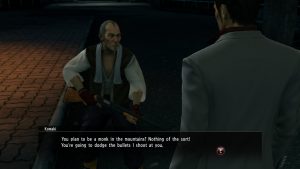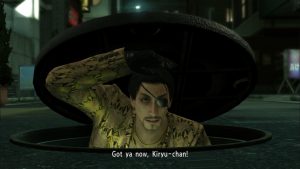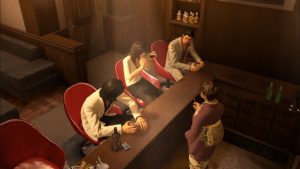
2016 would be a productive year for the series, as RGG Studio would release two different games before the year was up. While the big one is definitely 6 and the reveal of the Dragon Engine, Yakuza Kiwami (the subtitle roughly meaning “extreme” in English) played an important role of making the first game’s story playable for western audiences, since they were too stingy to just give us the PS2 remasters. This was a full remake in the architecture of Yakuza 0, a fundamentally better playing game than the original, but that makes it odd by how it somehow introduces new issues to the original game. On top of that, its additive goals create an experience lacking in cohesion, even more so than usual for the series.

The general story beats of the original are all present and accounted for, the one major change being a lack of an English dub and an improved localization, which cuts back the obnoxious cussing storms of the original English version. The other major change relates to your first fight with Majima, as he properly shows his tattoos for the showdown instead of keeping his outfit on the whole game. The scene also seems to have been changed a bit to make him a less threatening figure, and the first encounter with him has a similar treatment in order to set up the Majima Everywhere system for the side content. Otherwise, the game is faithful to the original version, though it also adds a lot of new scenes of questionable quality.
The start of the game now has a very awkward sequence where you buy Yumi a ring that includes the baffling decision of having Shinji think Kiryu is into soapland girls. It just drags out the start and adds nothing of any real significance besides some pretty lame gags. There’s additional cutscenes showing what happened to Nishiki to make him turn cold blooded while Kiryu was in jail, and the core idea is fine enough. The execution feels a tad awkward, though, and paints Kazama’s relationship with one of his boys in a really weird light that does not click with how he acts in the main game’s story. There’s also attempts in some new substories to try and patch up holes in the story caused by 0 related to the third chairman, and they’re just really unnecessary. Where things start getting comically out of place is Majima himself, as the attempts to weave his main story stuff with his goofy Kiryu harassing shenanigans causes a lot of weird issues to try and patch up certain beats.

Gameplay wise, if you played Yakuza 0, this will feel very familiar. Kiryu will be rocking his prequel styles through this version of the game, with his classic style, labeled here the dragon style, almost functionally useless for most of the game. Leveling works like a mix of the original, with experience, while also using a grid system like 0. Dragon style is where things get a little weird, as it is directly connected to the much advertised Majima Everywhere system.
You may notice that there’s a lot of odd requirements for unlocking dragon style moves, relating to your one-eyed friend who won’t stop leaving you alone. This remake’s big gimmick is that Majima will be all over the game, randomly appearing on the map, coming out of manholes or from under that large traffic cone, and having dedicated encounters via minigames and set events. To go through the grid, you need to do specific encounters with him, which will unlock the potential of said style. By end game, dragon style’s damage output will be so insane (alongside learning Komaki moves like the tiger drop) that it will make the 0 styles obsolete. Strong idea conceptually, but the execution isn’t ideal.

The big issue that keeps this from being really rewarding is that after a set number of Majima encounters, including random street encounters, the encounters will dry up until you make story progress after getting a set number of skills. Since you have to go through a grid, this means you might miss out on major attack boosts on said grid for the majority of the game because they require very specific encounters that aren’t spelled out to you. This means you can get a chunk of upgrades every chapter or so, but not the necessary damage upgrades and improvements to make the dragon style work unless you have a guide with you to tell you the way to get through the grid efficiently. You might also get tired of fighting Majima so much, even with his many styles and gimmicks, especially if you have high levels of tiger drop fu. You’ll get more out of him by going into quickstep duels with rush style.
We also run into an issue with another new gimmick. There are now added modes for bosses, where they will turtle up and start healing back all their health, and can’t be easily knocked down. Kiryu is meant to use specialized heat moves for these moments, kiwami heat moves – which have to be unlocked in the grids. This is a problem with the first Yakuza in particular because the start of the game is mostly just cutscenes and a long string of boss fights before you can start properly leveling. This leads to a huge brick wall moment with the Shimano fight at the funeral for the third chairman early in the game, as he will turtle up and regain his health, and you will most likely not have the specific kiwami move you need to punish him. This causes the fight to go on for a LONG time, and with a lot of frustration. Consult a guide when you start playing to save some headaches.

Other than that, the side stuff is a mix of what was already in the original, meaning you get a lot of pretty subpar substories (including a transphobic one revolving around a pair of scammers), and reused 0 stuff. The latter fairs way better, as we get some sequel stories to previous stuff like the pocket racer saga, or better takes on previous ideas. The cat fight stuff gets cheekily remixed into a children’s card game played with arcade machines, complete with substories and an additional layer of depth with card stats. Now the cheesecake is goofy and works as an actual game mode.
As for the soundtrack, we got new takes on old tracks, often to better fit the fact that there are no longer minute long wait times to deal with so less build up in themes is needed. The new version of Scarlet Scar lacks the sick build the original for this reason, but is otherwise solid. The music on the whole does its job but isn’t quite as memorable as the production style of the PS2 era music, though we do have some clear glow-ups. Nishiki’s For Whose Sake gets a huge improvement in particular, adding a dramatic, exciting edge to the track, while keeping the original melancholy in the mix. It makes for a far more memorable final boss theme.

Yakuza Kiwami isn’t the ideal way to play the original game. That would be a remaster with fixed combat. However, some of its new ideas do work, and there’s definitely laughs to be had in the many Majima encounters, even if they don’t always fit the framework. It’s really just more Yakuza 0 gameplay wrapped up with the first game’s narrative, and works as a good entry point as a result. Just be aware of some odd pitfalls the game has starting out.
It’s certainly better than the other 2016 RGG Studio joint, a game that polarizes the fanbase to this very day.































